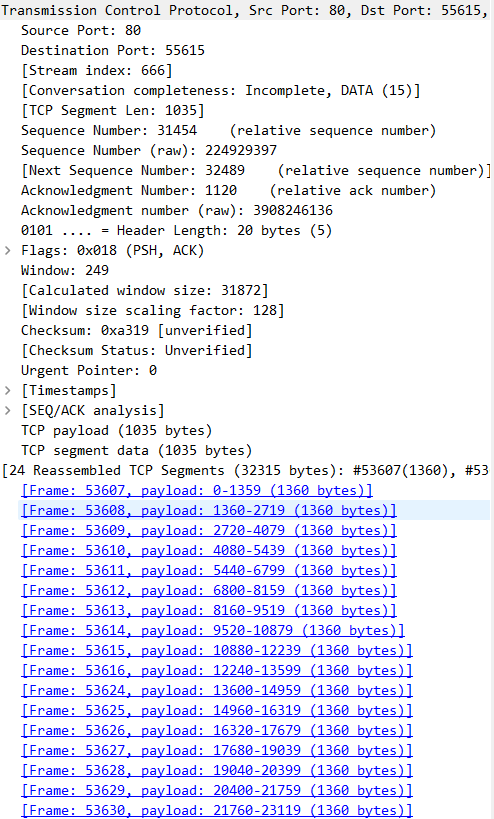transfer encoding 将 entity 安全传递给用户所采用的编码形式 分块编码
小结:
1、实践
Transfer-Encoding: chunked
分块编码主要应用于如下场景,即要传输大量的数据,但是在请求在没有被处理完之前响应的长度是无法获得的。例如,当需要用从数据库中查询获得的数据生成一个大的 HTML 表格的时候,或者需要传输大量的图片的时候。

服务端设置




HTTP chunked response
浏览器

修改服务端设置
Transfer-Encoding - HTTP | MDN https://developer.mozilla.org/en-US/docs/Web/HTTP/Headers/Transfer-Encoding
Transfer-Encoding - HTTP | MDN https://developer.mozilla.org/zh-CN/docs/Web/HTTP/Headers/Transfer-Encoding
Transfer-Encoding 消息首部指明了将 entity 安全传递给用户所采用的编码形式。
Transfer-Encoding 是一个逐跳传输消息首部,即仅应用于两个节点之间的消息传递,而不是所请求的资源本身。一个多节点连接中的每一段都可以应用不同的Transfer-Encoding 值。如果你想要将压缩后的数据应用于整个连接,那么请使用端到端传输消息首部 Content-Encoding 。
当这个消息首部出现在 HEAD 请求的响应中,而这样的响应没有消息体,那么它其实指的是应用在相应的 GET 请求的应答的值。
| Header type | Response header |
|---|---|
| Forbidden header name | yes |
语法
Transfer-Encoding: chunked Transfer-Encoding: compress Transfer-Encoding: deflate Transfer-Encoding: gzip Transfer-Encoding: identity // Several values can be listed, separated by a comma Transfer-Encoding: gzip, chunked
指令
chunked-
数据以一系列分块的形式进行发送。
Content-Length首部在这种情况下不被发送。。在每一个分块的开头需要添加当前分块的长度,以十六进制的形式表示,后面紧跟着 '\r\n' ,之后是分块本身,后面也是'\r\n' 。终止块是一个常规的分块,不同之处在于其长度为 0。终止块后面是一个挂载(trailer),由一系列(或者为空)的实体消息首部构成。 compress-
采用 Lempel-Ziv-Welch (LZW) 压缩算法。这个名称来自 UNIX 系统的 compress 程序,该程序实现了前述算法。 与其同名程序已经在大部分 UNIX 发行版中消失一样,这种内容编码方式已经被大部分浏览器弃用,部分因为专利问题(这项专利在 2003 年到期)。
deflate-
采用 zlib 结构 (在 RFC 1950 中规定),和 deflate 压缩算法 (在 RFC 1951 中规定)。
gzip-
表示采用 Lempel-Ziv coding (LZ77) 压缩算法,以及 32 位 CRC 校验的编码方式。这个编码方式最初由 UNIX 平台上的 gzip 程序采用。处于兼容性的考虑,HTTP/1.1 标准提议支持这种编码方式的服务器应该识别作为别名的
x-gzip指令。 identity-
用于指代自身(例如:未经过压缩和修改)。除非特别指明,这个标记始终可以被接受。
示例
分块编码
分块编码主要应用于如下场景,即要传输大量的数据,但是在请求在没有被处理完之前响应的长度是无法获得的。例如,当需要用从数据库中查询获得的数据生成一个大的 HTML 表格的时候,或者需要传输大量的图片的时候。一个分块响应形式如下:
HTTP/1.1 200 OK Content-Type: text/plain Transfer-Encoding: chunked 7\r\n Mozilla\r\n 9\r\n Developer\r\n 7\r\n Network\r\n 0\r\n \r\n
The Transfer-Encoding header specifies the form of encoding used to safely transfer the payload body to the user.
Note: HTTP/2 disallows all uses of the Transfer-Encoding header other than the HTTP/2 specific: "trailers". HTTP 2 provides its own more efficient mechanisms for data streaming than chunked transfer and forbids the use of the header. Usage of the header in HTTP/2 may likely result in a specific protocol error as HTTP/2 Protocol prohibits the use.
Transfer-Encoding is a hop-by-hop header, that is applied to a message between two nodes, not to a resource itself. Each segment of a multi-node connection can use different Transfer-Encoding values. If you want to compress data over the whole connection, use the end-to-end Content-Encoding header instead.
When present on a response to a HEAD request that has no body, it indicates the value that would have applied to the corresponding GET message.
| Header type | Request header, Response header, Payload header |
|---|---|
| Forbidden header name | yes |
Syntax
Transfer-Encoding: chunked
Transfer-Encoding: compress
Transfer-Encoding: deflate
Transfer-Encoding: gzip
// Several values can be listed, separated by a comma
Transfer-Encoding: gzip, chunked
Directives
chunked-
Data is sent in a series of chunks. The
Content-Lengthheader is omitted in this case and at the beginning of each chunk you need to add the length of the current chunk in hexadecimal format, followed by '\r\n' and then the chunk itself, followed by another '\r\n'. The terminating chunk is a regular chunk, with the exception that its length is zero. It is followed by the trailer, which consists of a (possibly empty) sequence of header fields. compress-
A format using the Lempel-Ziv-Welch (LZW) algorithm. The value name was taken from the UNIX compress program, which implemented this algorithm. Like the compress program, which has disappeared from most UNIX distributions, this content-encoding is used by almost no browsers today, partly because of a patent issue (which expired in 2003).
deflate-
Using the zlib structure (defined in RFC 1950), with the deflate compression algorithm (defined in RFC 1951).
gzip-
A format using the Lempel-Ziv coding (LZ77), with a 32-bit CRC. This is originally the format of the UNIX gzip program. The HTTP/1.1 standard also recommends that the servers supporting this content-encoding should recognize
x-gzipas an alias, for compatibility purposes.
Examples
Chunked encoding
Chunked encoding is useful when larger amounts of data are sent to the client and the total size of the response may not be known until the request has been fully processed. For example, when generating a large HTML table resulting from a database query or when transmitting large images.
A chunked response looks like this:
HTTP/1.1 200 OK
Content-Type: text/plain
Transfer-Encoding: chunked
7\r\n
Mozilla\r\n
11\r\n
Developer Network\r\n
0\r\n
\r\n



 浙公网安备 33010602011771号
浙公网安备 33010602011771号